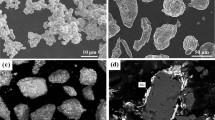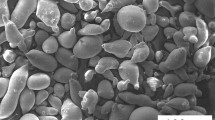Abstract
A cast iron coating is a prime candidate for the surface modification of aluminum alloys for antiwear applications because cast iron is inexpensive and exhibits superior wear resistance arising from the self-lubricating properties of graphite. In the present study, fundamental aspects of a plasma sprayed cast iron coating on an aluminum alloy substrate, including (1) the effects of preheat substrate temperature on the splat morphology, (2) the formation of a reaction layer and pores, and (3) the splat microstructure, were investigated in low-pressure plasma spraying. With an increasing substrate temperature, the splat morphology changes from a splash type to a disk and star shape. Deformed substrate ridges mainly resulting from the slight surface melting, are recognized adjacent to the splat periphery at high substrate temperatures. The flattening ratio of disk splats decreases with substrate temperature because the ridges act as an obstacle for splat expansion. A reaction layer composed of iron, aluminum, and oxygen is ready to form at high substrate temperatures, which, along with the deformed ridges, improves the adhesive strength of splats. However, the pores appear at the splat interface at low substrate temperatures, which hinder the formation of a reaction layer. The amount of graphitized carbon increases in cast iron splats with an increase in substrate temperature.
Similar content being viewed by others
References
M. Ebisawa, T. Hara, T. Hayashi, and H. Ushio: “Production Process of Metal Matrix Composite (MMC) Engine Block,” SAE Tech. Paper Series, 910835, 1991.
K. Funatani, K. Kurosawa, P.A. Fabiyi, and M.F. Puz: “Improved Engine Performance via Use of Nickel Ceramic Composite Coatings,” SAE Tech. Paper Series, 940852, 1994.
M.R. Kim and R.W. Smith: “High-Deposition Rate Coating of Aluminum Cylinder Bores” in Proceedings of the 7th National Thermal Spray Conference, Boston, MA, 1994.
L. Byrnes and M. Kramer: “Method and Apparatus for the Application of Thermal Spray Coatings onto Aluminum Engine Cylinder Bores” in Proceedings of the 7th National Thermal Spray Conference, Boston, MA, 1994.
G. Wuest, G. Barbezat, and S. Keller: “The Key Advantages of the Plasma-Powder Spray Process for the Thermal Spray Coating of Cylinder Bores in Automotive Industry,” SAE Tech. Paper Series, 970016, 1997.
A. Rabiei, D.R. Mumm, J.W. Hutchinson, R. Schweinfest, M. Ruhle, and A.G. Evans: “Microstructure, Deformation and Cracking Characteristics of Thermal Spray Ferrous Coatings,” Mater. Sci. Eng., 1999, A269, pp. 152–65.
K. Murakami, T. Okamoto, Y. Miyamoto, and S. Nakazono: “Rapid Solidification and Self-Annealing of Fe-C-Si Alloys by Low Pressure Plasma Spraying,” Mater. Eng. Sci., 1989, A117, pp. 207–14.
R. McPherson: “The Relationship between the Mechanism of Formation, Microstructure and Properties of Plasma Sprayed Coatings,” Thin Solid Films, 1981, 83, pp. 297–310.
T. Watanabe, I. Kuribayashi, T. Honda, and A. Kanzawa: “Deformation and Solidification of a Droplet on a Cold Substrate,” Chem. Eng. Sci., 1992, 47(12), pp. 3059–65.
C.S. Marchi, H. Liu, E.J. Lavernia, R.H. Rangel, A. Sickinger, and E. Muehlberger: “Numerical Analysis of the Deformation and Solidification of a Single Droplet Impinging onto a Flat Substrate,” J. Mater. Sci. 1993, 28, pp. 3313–21.
C.C. Berndt, W. Brindley, A.N. Goland, H. Herman, D.L. Houck, K. Jones, R.A. Miller, R. Neiser, W. Riggs, S. Sampath, M. Smith, and P. Spanne: “Current Problems in Plasma Spray Processing,” J. Therm. Spray Technol., 1992, I(4), pp. 341–56.
R.C. Dykhuizen: “Review of Impact and Solidification of Molten Thermal Spray Droplets,” J. Therm. Spray Technol., 1994, 3(4), pp. 351–61.
A. Hasui, S. Kitahara, and T. Fukushima: “On Relation between Properties of Coating and Spraying Angle in Plasma Jet Spraying,” Trans. Natl. Res. Inst. Met., 1970, 12(1), pp. 9–20.
V.V. Sobolev: “Morphology of Splats of Thermally Sprayed Coatings” in Thermal Spray Meeting the Challenges of the 21st Century, l, C. Coddet, ed., ASM International, Metals Park, OH, 1998, pp. 507–10.
M. Fukumoto and Y. Huang: “Flattening Mechanism in Thermal Sprayed Nickel Particles Impinging on Flat Substrate Surface,” J. Thermal Spray Technol., 1999, 8(3), pp. 427–32.
M. Fukumoto, S. Katoh, and I. Okane: “Splat Behavior of Plasma Sprayed Particles on Flat Substrate Surface, Thermal Spraying—Current Status and Future Trends,” A. Ohmori, ed. J. High Temp Soc., 1, 1995, pp. 353–58.
C. Moreau, P. Cielo, and M. Lamontagne: “Flattening and Solidification of Thermally Sprayed Particles,” J. Therm. Spray Technol., 1992, I(4), pp. 317–23.
M. Fukumoto, T. Yokoyama, K. Oku, and Y. Tanaka: “Optimization of Substrate Preheating Condition on Adhesive Strength of Thermal Sprayed Coating,” J. High Temp. Soc., 1997, 23(Suppl.), pp. 240–46.
G.H. Geiger and D.R. Poirier: Transport Phenomena in Metallurgy, Addison-Wesley, Reading, MA, 1973, pp. 329–49.
Author information
Authors and Affiliations
Rights and permissions
About this article
Cite this article
Morks, M.F., Tsunekawa, Y., Okumiva, M. et al. Splat morphology and microstructure of plasma sprayed cast iron with different preheat substrate temperatures. J Therm Spray Tech 11, 226–232 (2002). https://doi.org/10.1361/105996302770348880
Received:
Revised:
Issue Date:
DOI: https://doi.org/10.1361/105996302770348880




